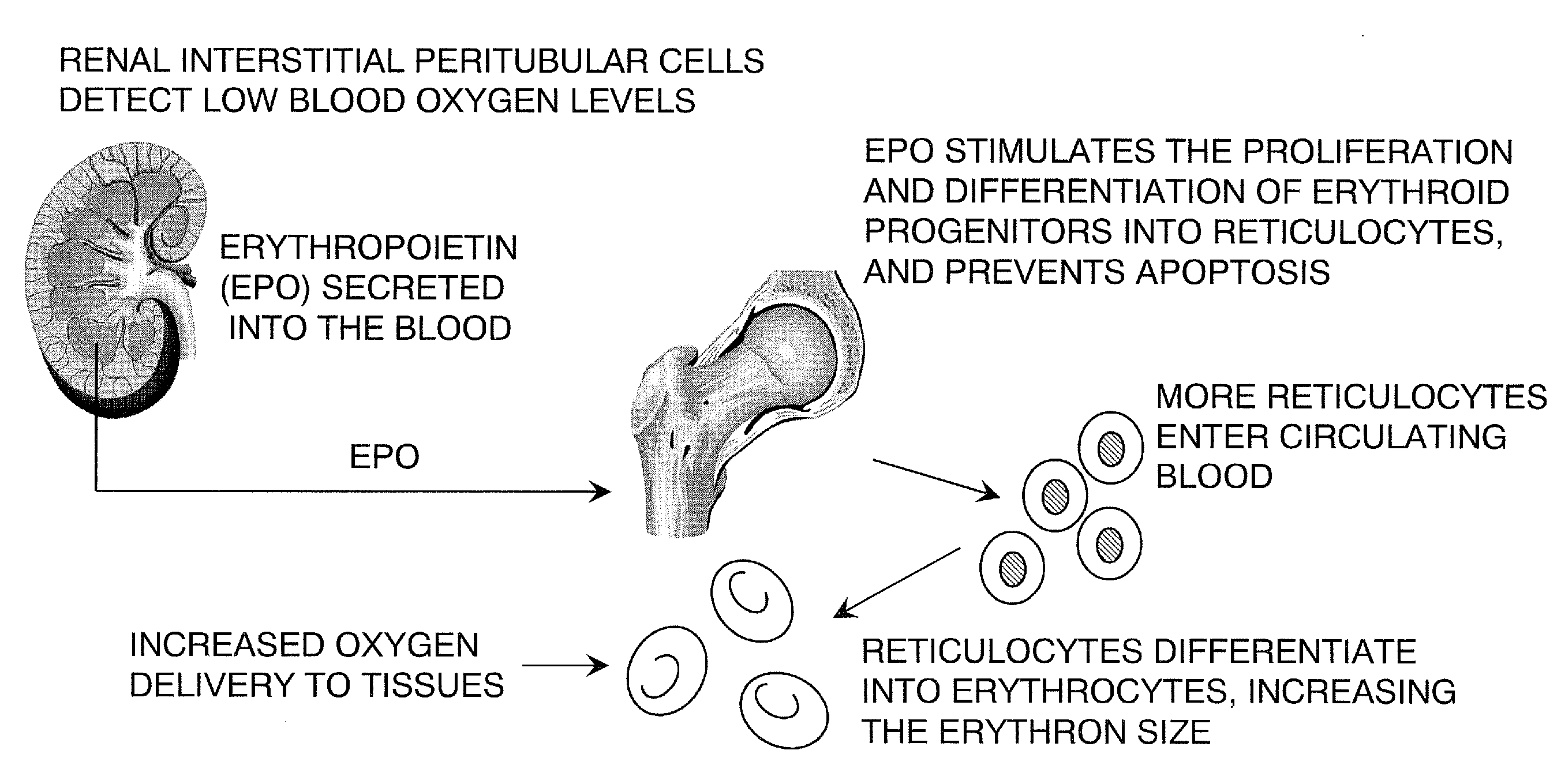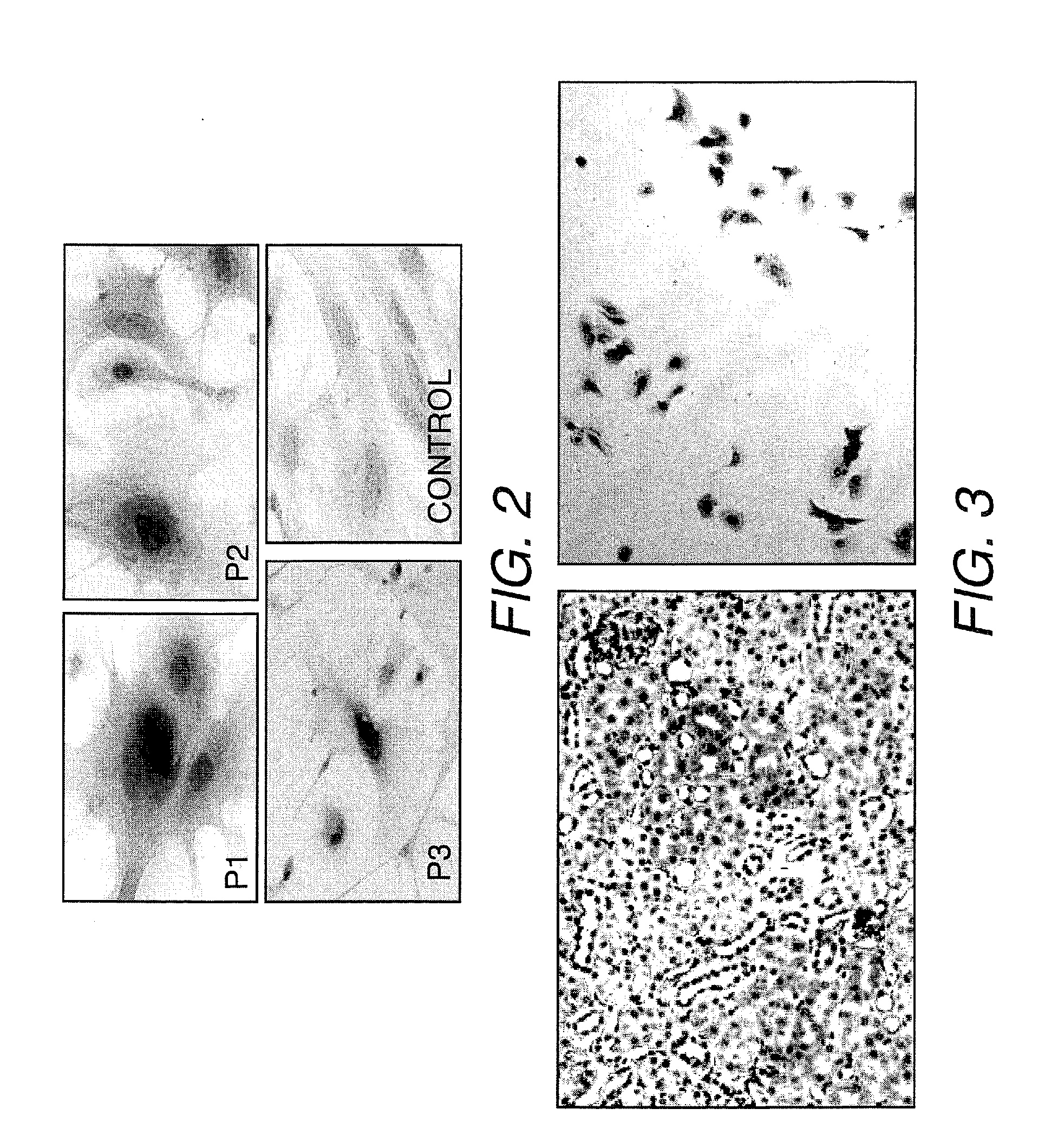Kidney structures and methods of forming the same
a kidney and organ technology, applied in the field of tissue regeneration, can solve the problems of prolonging survival, reducing survival rate, and grading kidney function loss
- Summary
- Abstract
- Description
- Claims
- Application Information
AI Technical Summary
Benefits of technology
Problems solved by technology
Method used
Image
Examples
example 1
Expansion of Renal Cell Primary Cultures
[0091]Renal cells from 7-10 day old mice C57BL / 6 were culture expanded. Minced kidney (1 kidney of mouse) was placed into a 50 cc tube with 15 ml of collagenase / dispase (0.2 mg / ml). The kidney tissue fragments were incubated in a 37° C. shaker for 30 min with collagenase / dispase mix (0.2 mg / ml; 15 ml). Sterile PBS with Gelatin (20 ml), was added (with Gelatin (DIFCO) 2 mg / ml) to the digestion solution. The mixture was filtered thorough a 70 micron filter to remove undigested tissue fragments. The collected solution was mixed well (being careful not to make air bubbles), and divided into two 50 cc tubes. The tubes were centrifuged at 1000(-1500) RPM for 5 min. The supernatant was discarded and the pellet of each tube was resuspended in 3 ml of KSFM medium. DMEM medium (10% FBS, 5 ml P / S) is used for stromal cells, and KSFM with BPE, EGF, 5 ml antibiotic-antimycotic, 12.5 ml FBS (Gemini Bio-Product, 2.5%), Insulin Transferrin Selenium (Roche) (5...
example 2
Characterization for EPO Production
[0095]The cells from early passages (1, 2 and 3) were characterized for EPO expression using immunocytochemistry and western blot analysis with specific antibodies (rabbit polyclonal anti-EPO antibodies, sc-7956, Santa Cruz Technologies, Santa Cruz, Calif.).
[0096]Renal cells were plated in 8-well chamber slides at a density of 3000 cells per well. The cells were incubated at 37° C. under 5% CO2 for 24 h to allow attachment. This was followed by fixation with 4% paraformaldehyde for 10 minutes at room temperature. Permeabilization of cell membranes was performed by adding 0.1% Triton-X 100 in PBS for 3 minutes at room temperature. Cells were then incubated in goat serum for 30 minutes at room temperature. After washing, cells were incubated with the primary antibodies for 1 h (1:50) at room temperature. Cells were washed a second time and biotinylated goat polyclonal anti-rabbit antibodies (polyclonal anti rabbit IgG, Vector Laboratories, Inc., Burl...
example 3
Mouse and Rat Renal Cell Characterization
[0100]FACS analysis was used to quantify the number of EPO-producing cells in the established renal cell cultures at each passage (1-3 passages). The cells were collected by trypsinization and centrifugation, resuspended in media, and passed through a 70 μm cell strainer to ensure a single cell suspension. After counting the cells, they were spun down and resuspended in PBS at 5-7.5×105 cells / tube to remove FBS from the cells. The cells were fixed with 2% formaldehyde for 10 minutes at 4° C. and permeabilized using 100% methanol for 10 minutes at room temperature. Subsequently, the cells were resuspended in 3% goat serum in PBS followed by incubation with the rabbit anti-EPO primary antibody sc-7956 (Santa Cruz Biotechnology, Santa Cruz, Calif.) for 45 minutes on ice. Cells were washed twice with 3% goat serum in PBS prior to incubation with fluorescein isothiocyanate (FITC)-conjugated goat anti-rabbit secondary antibodies for 1 hour. The cel...
PUM
 Login to View More
Login to View More Abstract
Description
Claims
Application Information
 Login to View More
Login to View More - R&D
- Intellectual Property
- Life Sciences
- Materials
- Tech Scout
- Unparalleled Data Quality
- Higher Quality Content
- 60% Fewer Hallucinations
Browse by: Latest US Patents, China's latest patents, Technical Efficacy Thesaurus, Application Domain, Technology Topic, Popular Technical Reports.
© 2025 PatSnap. All rights reserved.Legal|Privacy policy|Modern Slavery Act Transparency Statement|Sitemap|About US| Contact US: help@patsnap.com



